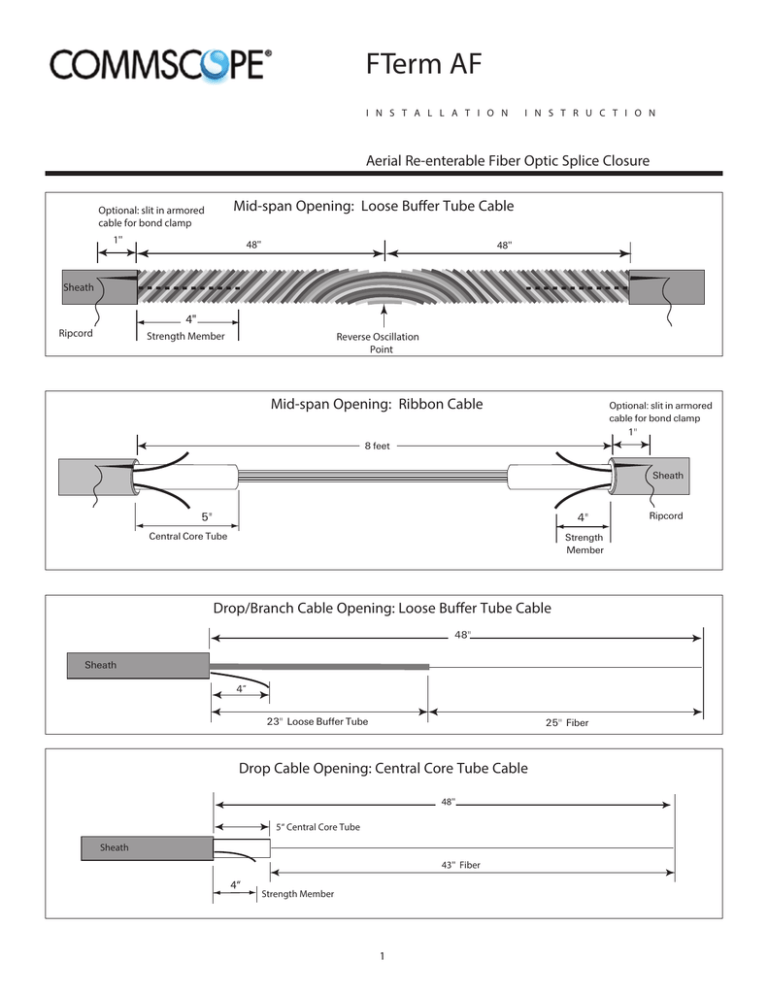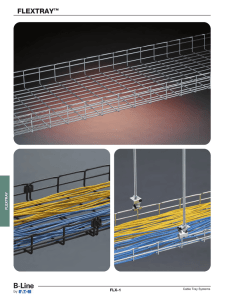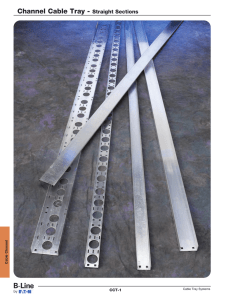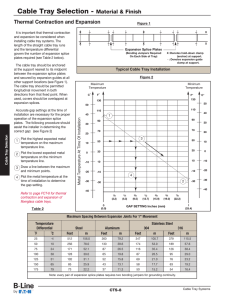
FTerm AF
I N S T A L L A T I O N
I N S T R U C T I O N
Aerial Re-enterable Fiber Optic Splice Closure
Mid-span Opening: Loose Buffer Tube Cable
Optional: slit in armored
cable for bond clamp
1''
48''
48''
Sheath
4"
Ripcord
Strength Member
Reverse Oscillation
Point
Mid-span Opening: Ribbon Cable
Optional: slit in armored
cable for bond clamp
1''
8 feet
Sheath
5"
4"
Central Core Tube
Strength
Member
Drop/Branch Cable Opening: Loose Buffer Tube Cable
48''
Sheath
4“
23'' Loose Buffer Tube
25'' Fiber
Drop Cable Opening: Central Core Tube Cable
48''
5“ Central Core Tube
Sheath
43'' Fiber
4“
Strength Member
1
Ripcord
Table 1: Midspan Cable Opening Dimensions
Bonding & Grounding: B-Bonds
Main Cable
Fiber Count
24 - 144 fibers
2 8 8 fibers
Midspan Cable Opening Length
Loose Buffer
Central Core Tube
Tube Cable
(Ribbon) Cable
*6 ft. - 10 ft.
*6 ft. - 10 ft.
*6 ft. - 1 0 ft.
* 6 ft. min. when length is cut downstream.
8 ft. min. length when cut at midpoint.
Hose
clamp
Installation Instructions
3.0 Warnings and Safety Precautions
1.0 General Product Information
Use company-approved safety practices and equipment when
installing the FTerm AF closure.
The FTerm AF aerial re-enterable fiber optic splice closure is
designed for strand mounted applications. The FTerm AF closure
can accommodate shielded or unshielded loose buffer tube or ribbon cables. The closure combines CommScope’ GelGuard sealing gel technology and FOSC fiber management systems.
4.0 Required Tools
•
•
The FTerm AF closure can accommodate one cable up to 1.25” in
diameter and two additional cables or up to eight small drop cables
when grouped together up to .75” in diameter in each end of the closure.
Flat head screw driver
216 tool (can wrench)
5.0 Mark and Open Cables
Splice trays come with two SM12 splice modules which will hold up
to 24 splices, provided that SMOUV splice sleeves are used (purchased separately, kit SMOUV-1120-01-US).
5.1 Mid-Span Cable
Note: This closure is not recommended for load-bearing ADSS
cable.
Note: For loose buffer tube cable, it is beneficial to locate the
reverse oscillation point and position it at the center of the opening.
2.0 Kit Components
2.
Mark the cable 48” from the center in each direction. Ring cut
the cable, and remove the jacket and shield, if present.
•
•
•
•
•
•
•
•
•
•
•
•
•
•
3.
For loose buffer tube or ribbon cable, cut each strength member 4” from each sheath ring cut. (Figures 1, 2)
4.
For core tube cable, remove all but 5” of central core tube at
each end of the sheath opening. (Figure 2)
5.
Clean exposed ribbons or buffer tubes with a clean cloth and
company approved degreaser.
1.
Housing
Frame/hanger assembly
Splice organizer tray (not included in all kits)
Gel-filled end pieces
Small Tie wraps
Foam tape
Hose clamps
Velcro fastener strip
Loose buffer tube wrap 1”x12”
Perforated metal squares
Transport tubing 16” and 36”
Routing rings
Tray tabs
Diameter tape
Locate a loop of fiber optic cable roughly eight feet in circumference. Mark the center of the loop.
5.2 Grounding Shielded Cables
The FTerm AF closure kit can be ordered in a grounded or ungrounded configuration. If the grounded kit is ordered, the ground straps are
factory installed and ready to use. If the ungrounded kit is ordered
but grounding is later required, order the AIR FOSC closure grounding kit and follow the installation instructions included with that kit.
2
Place approved bond clamps 90° from the top of the cables. To prepare shielded cables for grounding, install a B-bond clamp. Open a 1”
slit in the sheath beyond the ring cut 90° from the top of the cables.
Insert the lower portion of the B-bond under the shield with the stud
protruding through the slit, and wrap with vinyl tape. Place the top
plate over the stud and tighten it down with the nut. Recommended
torque 40 in. lbs. Wrap the exposed area with vinyl tape. (Figure 3)
1''
Optional: slit in armored
cable for bond clamp
4"
6. Open Housing and Hang Frame
1.
1''
Open housing using a can wrench to loosen the 3 bolts. To
remove the frame grab the edge of the housing with your
hands and push up on the bottom of the frame with your
thumbs to release the frame from the housing. (Figure 4)
Figure 1
Optional: slit in armored
cable for bond clamp
NOTE: Terminal cables should be added to the housing before
re-attaching to the frame. This is best done while on the
ground. Refer to section 10.
4"
2.
Hang and secure the frame on the strand centering it over the
midspan cable opening.
5"
Figure 2
7. Attach Midspan Cable to Frame and Bond
1.
Loosen the top bottle cap.
Note: Do not use tape on cable sheath under hose clamp.
2.
Slide the strength member(s) under the bottle cap washer; and
continue pushing until the end of the strength member(s) is
trapped under the lip of the frame. Tighten the bottle cap.
(Figure 5)
Figure 3
Note: If strength member(s) contain an outer jacket, it may
need to be shaved off before fiberglass strength members will
fit under the lip of the frame.
Figure 4
Figure 5
3
3.
Front View
Place a large hose clamp around the cable and frame. Place a
perforated metal square between the cable and hose clamp.
(Figure 6) Tighten hose clamp to 40 in.lbs.
Repeat for opposite end of splice opening.
8. Prepare Midspan Fibers for Splicing
or Storage
8.1 Loose Buffer Tube (LBT) Cable
Figure 6
1.
Separate the buffer tube containing the fibers to be spliced
from any remaining buffer tubes. Remove clear plastic cover
from back of frame, or slide to one side. Push the unused loose
buffer tubes through the window in the frame; push one side
through first and let it “lead” the other side through so the
buffer tubes don’t kink.
2.
Coil and store the express buffer tubes using the 2” Velcro
pads and 1/2” strips as shown in Figure 7. Be careful not to
kink the tubes.
Note: If cable storage is too large, tie wraps can be used in
place of plastic cover. Do not overtighten the ties.
3.
Re-position the plastic cover on the back of the frame.
4.
Mark the buffer tube containing the desired fibers 23” from
each sheath opening. Remove the buffer tube from the fibers
between the marks per company-approved practice. Clean the
exposed fibers with a clean cloth and company-approved
degreaser.
5.
Route the buffer tube along the top of the frame and down to
the back side of the tray for attachment. Attach to upper holes
with tie wraps. Recommended that you wrap one layer of
loose buffer tube wrap around buffer tubes where tie wraps
are used. (Figure 8)
Back View
Figure 7
Note: If buffer tubes are too stiff to route to the tray, remove
the buffer tube and apply spiral wrap on the exposed uncut fibers
to protect them, and route them to a splice tray for storage.
6.
Cut a small piece of loose buffer tube wrap and wrap one layer
around the end of each buffer tube where it will enter the
splice tray. (Figure 8) Secure each buffer tube to the splice tray
with two tie wraps.
Note: Heads of tie wraps must face upwards on the tray.
7.
Figure 8
4
Cut the fibers to be spliced and store the remainder on the
tray. (See Figures 30A, 30B, and 30C for storage.)
8.2 Ribbon Cable
Note: When using a tie wrap to secure central core tube to the
frame, wrap the central core tube with LBT wrap first to prevent the tie wrap from crushing the core tube.
IMPORTANT: Instructions for storing ribbon cable on the FOSC
Ribbon Tray are included with the ribbon tray kit. The process
is not covered in these instructions.
1.
Secure the core tube to the frame with tie wraps through the
holes in the frame. (Figure 9)
2.
Identify the ribbon containing the fibers to be spliced, and separate it from the other ribbons. Remove clear plastic cover from
back of frame, or slide to one side. Push the unused ribbons
through the window in the frame and allow them to hang in a
loop behind the frame. Hint: push one side through first, and let
it “lead” the other side through so the ribbons do not kink.
3.
Organize, coil, and store the uncut ribbons in the back of the
frame using the 2” Velcro pads and 1/2” strips. Re-position the
plastic cover on the back of the frame. (Figure 10)
4.
Cut the ribbon containing the fibers to be spliced. If cutting the
fibers dead-to-the-field, cut the ribbon as close to the field side
(ONU side) of the splice opening as possible. If the fibers are
part of a loop architecture, cut them in the middle of the splice
opening. Transportation tubing must be used to route to tray
for straight splice applications.
5.
Figure 9
Back View
Use a 16” section of transportation tubing and use it to protect
the fibers from the selected ribbon. Route the encased fibers
from the top of the frame to the back of the splice tray. Secure
transportation tube to frame with tie wraps. (Figure 11)
Figure 10
Note: If necessary, wrap the end of the ribbon with vinyl tape to
make it easier to slide the ribbon through the spiral wrap.
9. Prepare Drop Cables for Splicing or Storage
9.1 LBT Drop Cables
1.
Remove 48” of cable jacket. Mark and remove 25” of buffer
tube.
2.
Cut each strength member 4” from the sheath ring cut. Install
bond hardware if applicable. See section 5.2.
9.2 Ribbon Drop Cables
1.
Remove 55” of cable jacket. Remove all but 5” of core tube.
2.
Cut strength members 4” from sheath ring cut.
3.
Slide a 16” piece of transportation tubing over the fibers,
extending 1” over the central core tube. Install bond hardware
if applicable. See section 5.2.
Figure 11
5
9.3 Attach Drops To Frame
1.
Wrap the drop cable with a perforated metal square where it
will be under the hose clamp. (Figure 12)
Note: For multiple cables see Figure 12 for placement of metal
square to prevent the cable jackets from slipping against each
other under the hose clamp.
2.
Slide cable and strength member(s) under the nearest bottle
cap washer. Continue pushing until the end of the strength
member is trapped under the lip of the frame, and tighten the
bottle cap.
3.
Place a small hose clamp around all drop cables and frame as
shown in Figure 12. Tighten the hose clamp.
4.
Cut a small piece of LBT wrap and wrap one layer around the
end of each buffer tube. Place the drop fibers to the front of
the splice tray. Figure 13 (see dotted line) depicts this procedure with loose buffer tube(s) cable. Secure the tube(s) to the
tray with two tie wraps.
5.
Attach the routing rings in any of the vertical holes shown in
Figure 14 to keep buffer tubes away from hinge area.
Figure 12
Figure 13
Figure 14
6
10. Connecting Termination Cables and
Installing Pigtails
1.
Unlatch and lift the terminal cover until it is in the locked position. (Figure 15)
2.
Insert the pigtail(s) into the fiber duct. (Figure 16)
3.
Plug in connectors 1 and 2 then adjust slack. (Figure 17)
4.
Plug in remaining connectors as shown in Figure 18.
5.
If needed readjust slack from the opposite side of the terminal.
Proceed to step 5, next page.
Figure 15
Figure 17
Figure 16
Figure 18
1
2
3
4
5
6
7
8
9
10
11
12
Figure 19
7
Figure 19a
1
2
3
4
5
6
7
8
9
10
11
12
Figure 19b
1
2
3
4
5
6
7
8
9
10
11
12
Figure 19c
1
2
3
4
5
6
7
8
9
10
11
12
Installing the Fanout
1.
Attach breakout box with fasteners provided as shown in
Figure 19a.
2.
Insert the 36” transportation tube into the duct. (Figure 19)
Insert fanout fibers into the transportation tube for routing to
tray.
3.
Plug in connectors . (Figures 19a, b, and c)
4.
If needed readjust slack from the opposite side of the terminal.
Drop 1
Drop 2
Figure 20
TracTape
Caution: Check connector bend radius on terminal side.
Note: If you have drop cables follow steps 5 and 6. If not,
continue with step 7.
5.
For a single drop cable apply a wrap of TRAC closure tape
around the drop cable jacket 4” from the sheath ring cut.
6.
For multiple drop cables that will share a port in the end piece,
wrap a layer of TRAC closure tape between the drop cables
and around them starting 4” from the sheath ring cut, as
shown in Figure 2. Do not exceed .75” total diameter in any
single port.
7.
Install the end pieces around the cables, with the end piece closure tab facing forward. (Figure 21) Install cable spacers per
company practice on either side of the closure so that the
cables are spaced properly and parallel to the strand as they
enter the end pieces.
8.
Wrap the closure housing around the frame with the bolts facing up. Place the body over the top two tabs of the frame, and
press the bottom two tabs into the opening of the housing until
they snap in place. (Figure 22)
Figure 21
Figure 22: Cutaway Side View
8
9.
On the front side place the bundle of pigtails or transportation
tubing under the pre-installed LBT or ribbon present on the
right side. (Figure 23) and over the pre-installed tubes
attached on the left side if present. (Figure 24)
10. Hold the pigtail bundle on the tray and mark the yellow tubing
one inch from the end of the tray. (Figure 25) From the mark,
measure out 22” for pigtails and fanout if de-ribbonized and cut
off evenly. Alternatively, if using ribbon tray, from the mark
measure out 35” for fanout.
Ribbon cannot be stored on a single tray, slack will have to be
pulled into the back of the frame.
Note: The length to the tray mark will be approximately 25”
from the fiber duct.
Figure 23
Figure 24
Figure 25
9
12. Cut and remove the yellow tubing and aramid fiber strands
from the mark. (Figure 26)
13. Wrap a piece of LBT wrap around the bundle of the pigtails or
transportation tube if using fanout. Remove tray and attach
pigtails or transportation tube with two tie wraps as shown in
Figure 27.
11. Splice Fibers and Store on Tray
Note: If kit contains a ribbon tray; follow ribbon tray instructions.
Fiber routing should follow the embossed arrows on the tray.
(Figure 28)
Figure 26
Do not store ribbon slack on single tray; pull ribbon slack from the
tray to the slack basket. See Figure 29 for routing and splicing ribbon
to ribbon cable.
Figure 27
Figure 28
Main
Drop
Figure 29
10
Figures 30a, 30b, and 30c illustrate examples of proper fiber
routing, though other arrangements are possible. Figure 30d
illustrates improper fiber routing.
Drop Cable Fibers
Main Cable Fibers:
Note: It is helpful to pre-organize your fibers on the tray prior
to splicing to determine the right configuration; routing
should match one of the diagrams in Figure 29 or 30a, b, or c.
Drop fibers
Figure 30A
Main cable fibers
Figure 30B
Figure 30C
WRONG! Both of these patterns will
cause signal attenuation!
Figure 30D
11
For easier splicing, remove tray from tray bracket, close bracket, cut
1” squares of both Velcro hook and eyes and join together. Remove
release paper from both sides and attach to frame. (Figure 31 )
Position tray over the top of the Velcro fastener and press in place.
(Figure 32)
When all splices have been completed and stored, install plastic tray
tabs on the arcs to help hold down the fibers. Replace the clear plastic tray cover.
12. Install Closure Body
1.
2.
Wrap the black Velcro fastener strap around the tray and tray
holder to keep the tray(s) in place. Lift the tray bracket so that it
hinges and snaps closed against the frame. Avoid pinching
ribbons, buffer tubes, transportation tubes, etc. in the bracket.
Figure 31
Close the housing, making sure the ends align properly with
the end pieces. Fasten the supplied bolts to secure the body in
place. (Figure 33)
Figure 32
Figure 33
AIR FOSC, FTerm, GelGuard, SMOUV, TRAC, CommScope logo, and CommScope are trademarks.
Other trademarks are the properties of their respective owners.
Technical Assistance Center (TAC)
Tel.: 800.830.5056
Email: TAC.Americas@commscope.com
www.commscope.com
The information given herein, including drawings, illustrations and schematics which are intended
for illustration purposes only, is believed to be reliable. However, CommScope makes no warranties as to its accuracy or completeness and disclaims any liability in connection with its use.
CommScope’s obligations shall only be as set forth in CommScope’s Standard Terms and
Conditions of Sale for this product and in no case will CommScope be liable for any incidental,
indirect or consequential damages arising out of the sale, resale, use or misuse of the product.
Users of CommScope products should make their own evaluation to determine the suitability
of each such product for the specific application.
©2005, 2007, 2008, 2009, 2016 CommScope Inc. All Rights Reserved PML 977921 F508.2/09





